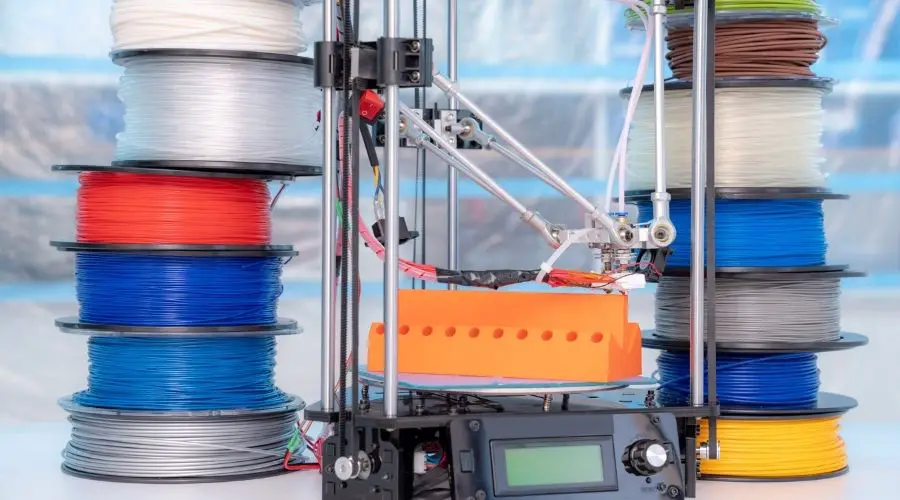When it comes to 3D printing, the material you use matters. While the type of printer can make a huge difference, the material will make the piece look and feel great.
PLA and ABS plastic are two of the most common options for 3D printers. However, they both have advantages and disadvantages that can affect your finished work. So, let’s break down PLA vs ABS and see how they compare.
PLA is a light thermoplastic that melts quickly and doesn’t warp easily. It’s ideal for hobbyists and consumer-grade 3D printing. ABS is a bit tougher than PLA. Most 3D print shops use ABS because it’s so light and impact-resistant.
What is PLA?
PLA stands for polylactic acid, and it’s a somewhat biodegradable substance. Typically, PLA is made from recycled materials, such as sugarcane or corn starch. You can find PLA in many industries and products, including medical implants, cups, and more.
Pros
- Eco-friendly material
- Easy to melt and shape
- Minimal warping
- Cost-effective
- Works well with most 3D printers
- Relatively strong and stiff
Cons
- Minimal heat resistance means that PLA can melt, even once printed
- Little chemical resistance
- Not as durable as other materials
- Rate of moisture absorption can be a problem
What is ABS?
ABS stands for acrylonitrile butadiene styrene, and it’s used in many unique applications. Most industries use ABS for injection molding, such as for electronic parts and toys. Lego, for example, uses ABS plastic. This material has a better heat resistance and durability than PLA, but it can sometimes be brittle and crack easily.
Pros
- Extra-light filament
- Decent heat resistance
- Moderate strength and durability
- Excellent impact resistance
Cons
- Higher heat resistance means that ABS is harder to print
- Prone to warping
- Little chemical resistance
- Can be brittle in some cases
Comparing PLA vs ABS
Knowing how each material acts on its own is good, but how do they compare to each other? If you’re new to 3D printing, you have to understand the limitations of each option so that you know what to choose for specific projects.
For example, ABS can work well for low-stress applications, thanks to its impact resistance and durability. By comparison, PLA is easier to mold, so it works well for beginners trying to turn their designs into real-life models.
So, let’s break down both materials based on
Print Accuracy
PLA’s main advantage is its low heat tolerance. So, it melts quickly and doesn’t warp too much when cooling. So, you don’t have to master your 3D printing techniques before working with PLA.
So, PLA works well for complex pieces with intricate components. ABS is better for larger, less sophisticated parts. PLA can also create sharper corners than ABS, although they’re not as durable.
Winner: PLA
Price
Fortunately, both materials are pretty cheap, making them ideal for 3D printers of all experience levels. The cost per spool is relatively identical, but ABS is slightly more cost-effective.
Winner: ABS
Eco-Friendliness
Since PLA is made from recycled materials, it’s much better for the environment. PLA pieces will degrade in water or industrial composters, but they stay stable under normal conditions. So, don’t worry about your PLA-printed piece eroding through normal wear and tear.
Unfortunately, ABS is not eco-friendly since it won’t break down naturally. However, you can recycle most ABS filament, so don’t worry about filling a landfill with excess or wasted material.
Winner: PLA
Post-Processing
Both materials will show a layered effect in the finished piece. If you want a smoother surface, you can sand and buff ABS components. Unfortunately, PLA is not ideal for smoothing as it can bend or melt by accident. Overall, you can file and drill PLA, but you have to be much more careful about doing it.
PLA has a naturally glossy finish, while ABS offers a matte finish. You can make ABS pieces shiny by adding acetone.
Winner: ABS
Durability
Here is where ABS shines over PLA. As we mentioned, many industries use ABS injection molding to create parts, illustrating the material’s strength and resilience. PLA, however, is better suited for rapid prototyping. While you can use PLA pieces, they’re not ideal for end-use applications.
Due to PLA’s low heat resistance, the parts can melt under relatively mild conditions. For example, if you print a PLA cup, it could warp or bend from your body heat if you hold it too long.
Winner: ABS
Toxicity
Although PLA can melt with hot food, the material itself is food-safe. So, companies can make prototypes of various food-related products, such as cups and measuring spoons. ABS isn’t toxic, but it can leach chemicals into food with prolonged contact. For that reason, ABS is not food-safe.
Winner: PLA
Final Verdict
As you can see, PLA and ABS are useful for specific situations. Sometimes, you may want to use both materials for the same project. For example, you can create a prototype with PLA to ensure that the design and structural elements are stable. Then, once you’ve made any adjustments, you can switch to ABS for the final piece. Happy printing!



